Get onboard! workshops: Getting students ready to travel safely
Get onboard! is a program designed to teach Grade 6 students in schools on the Island of Montreal all about using public transit. Through a classroom activity and a real-world rally, they’ll learn about safety rules, best (and worst!) practices on the bus and in the métro, and what to do if there’s an emergency.
Want your child to learn how to use public transit? Share this email address with their teacher so they can sign their class up for a workshop with our prevention team: SRSoutienPreventionnistes@stm.info
Teams to keep everyone safe
Our employees are there to help you during your trips. Their reassuring presence helps create a sense of safety on the network. Here are the different teams you can turn to when you need help.
Special constables
Special constables focus on prevention and assistance. They patrol the bus and métro networks to increase the sense of safety of customers and employees, ensure rider traffic flows smoothly and make sure rules are being followed.
They also support employees on the ground, who, at any time, can report a situation to a special constable, who will manage the event.
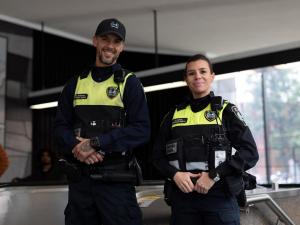
Learn more about the role of special constables
Safety ambassadors
Safety ambassadors, easily recognized by their blue and black uniforms, are active on the métro network.Offering customer support and a welcoming presence, feel free to reach out to them for assistance during your trips or to report any safety situation that may require the intervention of our teams.
They also support special constables to ensure smooth, safe travel for our customers, especially during service disruptions or crowded events.
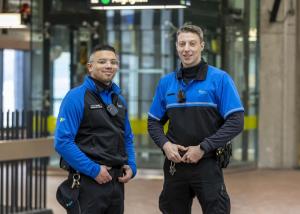
The métro unit of the City of Montréal police department (SPVM)
Police officers in the métro unit respond to situations on the bus and métro network and around stations to ensure the safety of customers, employees and business owners. They intervene proactively with a problem-solving approach to ensure that all users feel safe. Patrol officers from neighborhood police stations located near métro stations also respond to emergency calls.
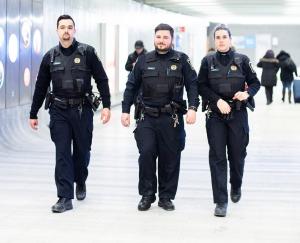
A network of security cameras
The métro network also has more than 2,500 cameras to help our teams, enabling real-time viewing and rapid response by the various resources.
Teams to support people in vulnerable situations
Like most major North American cities and transit networks, the STM operates in a complex social context, and the métro network is no exception.
To support people experiencing homelessness, we have teams dedicated to accompanying them and directing them to the right resources.
EMIC team
Each EMIC (Équipe métro d’intervention et de concertation) team is made up of an SPVM police officer, an STM special constable and a social worker from the Société de développement social (SDS). These teams are providing people in vulnerable situations with support specific to their needs and situation, to improve their quality of life and to direct them to appropriate resources.
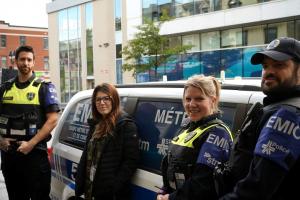
Taking a social and community approach in everything we do
Our special constables follow an intervention protocol to direct vulnerable people to the resources they need.
The STM has established a number of partnerships and agreements with the goal of increasing the presence of Health and Social Services and other organizations in the network and giving vulnerable people access to vital resources:
- Shuttle and taxi transportation to resources (if needed)
- Referrals to emergency shelters and supervised consumption sites
- Basic needs such as donated clothing and meal tickets (if needed)
- Health and social services, harm reduction, and crisis workers
All special constables, EMIC team members, and safety ambassadors also carry naloxone kits.
How to report an urgent situation requiring immediate assistance?
In any situation that may require urgent intervention in the metro network, you can notify an STM employee on site or use the following means to contact an STM employee.
In métro stations - use the assistance stations
Assistance stations are located on every métro platform and are identified by a blue light. They can be used to communicate directly with an STM employee for help during emergency situations.
- Locate the emergency station.
- Pull the red handle to cut power to the tracks ONLY if someone has fallen onto the tracks
- Pick up the red phone.
- Follow the instructions given to you by the person in charge.
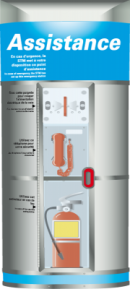
In métro cars - use the interphone
Every métro car is equipped with an intercom. You can use it to contact the train operator in case of an emergency or if you witness an incident. Don’t hesitate to move further away from the incident or switch métro cars to use the intercom if you need to.
- Use the intercom located in the middle of the car near the doors.
- The intercom allows you to speak with the train operator.
- Once the incident has been reported, an STM employee will wait for you on the platform of the next station to help you or the other person in need of assistance.
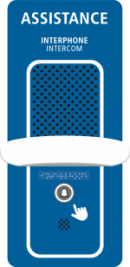
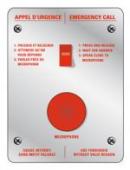
Use the emergency break for serious emergencies only
- It is located in the middle of the car near the doors.
- If possible, pull the emergency brake when the car is stopped at a station and the doors are open. The operator can then intervene more quickly and easily.
- If the emergency brake is pulled while the train is moving, the train will generally stop in the station or at the next one.
- The train operator will go to the car where the brake was pulled to assess the situation.
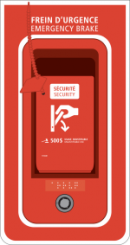
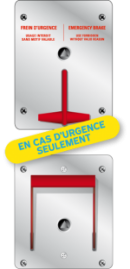
Call 911 in case of emergency
In an emergency that puts your safety or the safety of others at risk, call 911.
A mobile network is available throughout the métro, allowing you to make emergency calls wherever you are in the stations or métro cars.

Information to provide during emergency calls
To ensure that your call is handled quickly and efficiently, provide as much detail as possible about the situation, including your location and métro car five-digit number, if applicable.
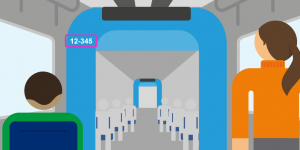
On the bus: notice the driver
In any situation that may require immediate assistance, notify the bus driver. They will be able to contact the appropriate resources to ensure the situation is handled appropriately.
How to report other situations that may require an intervention
In a métro station: Alert us via text
- If you want to let us know about a safety incident or issue in the métro, text us at 1-888-786-1119 with the location and details.
- You will receive a confirmation text as soon as we receive your report. A member of the Security and Fire Safety Team will review your report and take the necessary measures to address it.
In our network: write to us using the online form
- To report a situation that may compromise rider safety but does not require immediate attention, contact us through our online form and select the “Security issues” category.
- By selecting this option, your reports will be sent directly to our Transit Network Security team’s investigators.
Contact us through our online for
A few tips for your travels
Below is a reminder of the habits you should adopt to limit your risk during your daily commute.
 On the road
On the road
- Stay out of bus blind spots
- Make sure you’re visible
- Pay attention at intersections
- Keep your distance from buses
 In the métro
In the métro
- Keep your distances
- Never go onto the tracks
- Pay attention to your belongings
- What to do in case of emergency
 Around buses
Around buses
- Keep your distances
- Make eye contact
- Cross the street at the right and at the right time
- Hold on
 Around bikes
Around bikes
- Signal your intentions
- Stop at bus stops and stay behind the bus
- Make eye contact
- Pay attention to pedestrians who must cross the bicycle path to catch their bus
- Do not ride your bike in bus loops and terminuses
 On an escalator
On an escalator
- Hold the handrail
- Mind the stairs
- Avoid carrying bulky items
- Ask for help with your stroller
- Stand up
- Face the same direction taken by escalator
- Do not run
